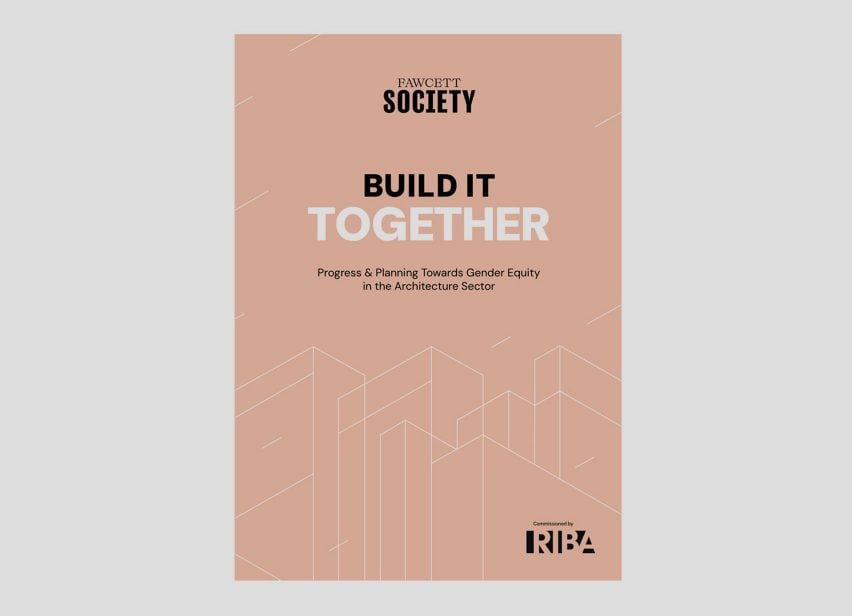Women working in architecture are more than twice as likely to feel that having children has harmed their career than women in the UK in general, a major RIBA-commissioned report has said.
Research conducted by gender-equality charity the Fawcett Society on behalf of the Royal Institute of British Architects (RIBA) found that 83 per cent of women architects with children feel that their career progress has been impacted by motherhood.
That compares to 38 per cent of women across the wider UK economy.
“Challenges highlighted 20 years ago persist today”
The finding is among a number of damning statistics about gender inequality in UK architecture contained within the 56-page report, published yesterday.
It was commissioned by the RIBA last year, shortly after Dezeen published an investigation into the lack of progress on the gender pay gap in UK architecture, and serves as a follow-up to a similar report launched in 2003.
“Our findings reveal that the challenges highlighted 20 years ago persist today: long hours being glorified, an imbalance of power between employers and employees, lack of clear policies and proactive action, and stark displays of sexism within practices,” yesterday’s report said.
“The problem, it can be concluded, is not a lack of knowledge or evidence about the issue or the inability to identify solutions, but an apparent absence of will at the highest levels of institutions to invest in the resources to embed equality.”
Interviews with women conducted by the Fawcett Society identified “several examples of blatant and uncompromising sexism”, according to the report.
 The report follows a similar report commissioned in 2003
The report follows a similar report commissioned in 2003
More than a third (35 per cent) of survey respondents said they had experienced sexual harassment at work, while 50 per cent had experienced bullying, with black and mixed- or multi-heritage respondents significantly more likely to have experienced bullying.
There was also evidence of widespread discrimination over pay. Among 534 women surveyed, 54 per cent discovered they were being paid less than a man at the same level.
It has been illegal to pay men and women different amounts for doing the same jobs in the UK since 1970.
“We see from this project and from our research, that there are too many women in the architecture profession who are being paid less or treated differently to their male colleagues,” said Fawcett Society chief executive Penny East.
“However, it is also clear that there is a real determination from women, from sector leaders, professional networks and from RIBA to pursue gender equality in architecture.”
“We hope that this report is read and absorbed not just by those who are already persuaded of the challenges, but by those who dismiss the issues or perhaps even perpetuate the problems directly.”
“I wanted some good news”
The report makes 47 recommendations, with 20 directed at the RIBA and the remainder for the government and architecture studios.
Among them are calls for the RIBA to monitor chartered practices’ HR policies and gender ethnicity pay gaps, and refuse to charter those that do not meet a base level of standards.
It also calls for the membership body to suspend its annual fee for people on maternity or parental leave of more than six months.
“This report lays bare the scale of architecture’s gender inequity crisis,” said RIBA chief executive Valerie Vaughan-Dick. “We cannot afford to lose talented women to outdated workplace cultures or structural inequity.”
“We therefore accept the report’s findings and note the recommendations – committing ourselves to meaningful action.”
Dezeen survey points to “broken” architecture and design industry
The RIBA has launched a one-year action plan to deliver on 10 of the report’s recommendations, and said the remaining recommendations “will be considered over a longer time frame”.
Ecologic Architects director Sumita Singha, who commissioned the 2003 report via the Architects for Change equality forum, said the new report showed that increasing numbers of women architects in the last 23 years “has not equated to increasing equity”.
“After decades of campaigning, legislation and women’s marches, I wanted some good news,” she told Dezeen. “Disappointingly, the new report highlights similar issues to the old one, with newer terminology.”
“Progression of women in architecture will increase the visibility, voices and value of women architects – as well as gender-mainstreaming of our buildings and cities,” she added.
The photo is by Charles Deluvio via Unsplash.


